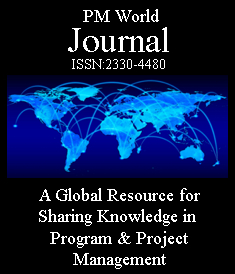A brief guide
Practical Project Risk Management
SERIES ARTICLE
By Martin Hopkinson
United Kingdom
Purpose
- Identify a common trap that projects fall into when conducting a quantitative (Monte Carlo) schedule risk analysis.
- Identify a process for developing schedule risk models that avoids this trap.
The Trap
A number of commercial risk management tools have been developed to support the integration of data from risk registers and project schedule planning tools to produce schedule risk models. The trap lies in the temptation to use labour saving features that such tools offer in ways that compromise modelling quality. Falling into this trap produces models that generate unrealistic and misleading results, often for reasons of which managers are unaware.
Description of a typical bad practice process
- The project’s master schedule is imported into the risk analysis tool to produce the model’s network of activities and dependencies.
- All risks from the risk register that have a schedule impact are linked to this network.
- The probabilities and three-point estimates for risks are imported from the risk register into the model. Three-point estimates for activities are generated using a standard metric e.g. planned remaining duration +/-10%.
- A Monte Carlo simulation is performed on the resultant model and the results published in reports prepared for management review.
This process is typically the easiest way of using the tools available. Unfortunately, it is also so deeply flawed that the results should be treated as being misleading and, potentially, worse than useless. However, this is not evident when looking at the results because they have the same appearance (e.g. S-curves and Tornado charts) as models of good quality and tend to produce optimistic forecasts. Managers are thus at risk of accepting the results at face value.
Reasons why using a master schedule to create a risk model is a bad idea
- A master schedule typically includes low levels of activity detail, using activities and dependencies that are very likely to change during the course of project delivery. It thus makes assumptions about certainty that are not rational in the context of simulating the implications of uncertainty. Almost all risk models with more than 200 activities are irrational for this reason, as are also many with fewer than 200 activities.
More…
To read entire article, click here
Editor’s note: This series of articles is by Martin Hopkinson, author of the books “The Project Risk Maturity Model” and “Net Present Value and Risk Modelling for Projects” and contributing author for Association for Project Management (APM) guides such as Directing Change and Sponsoring Change. These articles are based on a set of short risk management guides previously available on his company website, now retired. For an Introduction and context for this series, click here. Learn more about Martin Hopkinson in his author profile below.
How to cite this paper: Hopkinson, M. (2025). The Schedule Risk Modelling Tools Trap: A brief guide, Practical Project Risk Management series, PM World Journal, Vol. XIV, Issue VI, June. Available online at https://pmworldlibrary.net/wp-content/uploads/2025/06/pmwj153-Jun2025-Hopkinson-Schedule-Risk-Modelling-Detail-Trap.pdf
About the Author

Martin Hopkinson
United Kingdom
![]()
Martin Hopkinson, recently retired as the Director of Risk Management Capability Limited in the UK, and has 30 years’ experience as a project manager and project risk management consultant. His experience has been gained across a wide variety of industries and engineering disciplines and includes multibillion-pound projects and programmes. He was the lead author on Tools and Techniques for the Association for Project Management’s (APM) guide to risk management (The PRAM Guide) and led the group that produced the APM guide Prioritising Project Risks.
Martin’s first book, The Project Risk Maturity Model, concerns the risk management process. His contributions to Association for Project Management (APM) guides such as Directing Change and Sponsoring Change reflect his belief in the importance of project governance and business case development.
In his second book Net Present Value and Risk Modelling for Projects he brought these subjects together by showing how NPV and risk modelling techniques can be used to optimise projects and support project approval decisions. (To learn more about the book, click here.)
To view other works by Martin Hopkinson, visit his author showcase in the PM World Library at https://pmworldlibrary.net/authors/martin-hopkinson/









